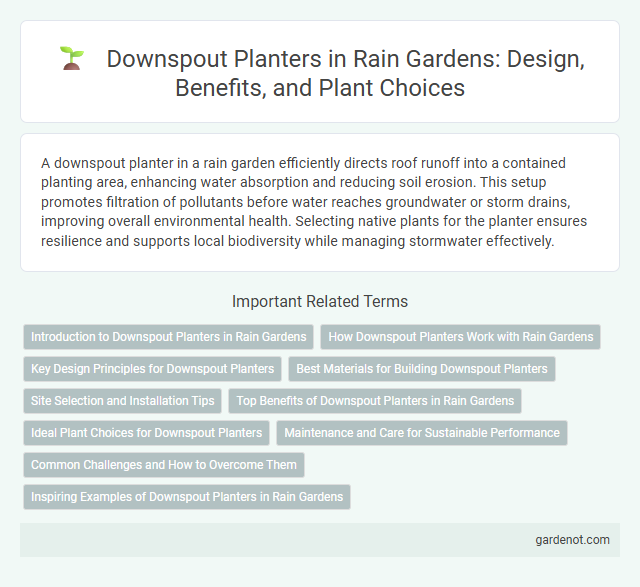A downspout planter in a rain garden efficiently directs roof runoff into a contained planting area, enhancing water absorption and reducing soil erosion. This setup promotes filtration of pollutants before water reaches groundwater or storm drains, improving overall environmental health. Selecting native plants for the planter ensures resilience and supports local biodiversity while managing stormwater effectively.
Introduction to Downspout Planters in Rain Gardens
Downspout planters in rain gardens effectively capture and filter stormwater runoff directly from roof downspouts, reducing erosion and improving water quality. These planters are strategically positioned to intercept flow, promoting infiltration and supporting native vegetation that enhances soil absorption. Integrating downspout planters into rain garden design optimizes stormwater management by slowing runoff and facilitating natural cleansing processes.
How Downspout Planters Work with Rain Gardens
Downspout planters direct roof runoff into rain gardens, reducing stormwater discharge and promoting groundwater recharge. By channeling water from downspouts into vegetated areas, they filter pollutants and decrease soil erosion. This integration enhances rain garden efficiency by managing water flow and supporting sustainable landscape drainage.
Key Design Principles for Downspout Planters
Key design principles for downspout planters include ensuring proper water flow management to prevent overflow and erosion while promoting infiltration into the soil. Incorporating native, water-tolerant plants enhances pollutant filtration and supports local biodiversity. Structural elements like overflow outlets and sediment traps improve system durability and maintenance efficiency.
Best Materials for Building Downspout Planters
Cedar and redwood are ideal materials for building downspout planters due to their natural resistance to rot and moisture, ensuring durability in rain garden environments. Recycled plastic lumber offers a sustainable and low-maintenance alternative, combining weatherproof qualities with ease of customization. Galvanized steel provides exceptional strength and corrosion resistance, making it suitable for downspout planters exposed to constant water flow.
Site Selection and Installation Tips
Site selection for a downspout planter requires well-draining soil and a location that receives moderate sunlight to support diverse plant growth. Install the planter at the downspout's end, ensuring it is level and connected to divert runoff effectively while preventing erosion. Incorporate a gravel layer at the bottom to enhance drainage and select native plants that tolerate both wet and dry conditions for optimal rainwater absorption.
Top Benefits of Downspout Planters in Rain Gardens
Downspout planters in rain gardens effectively manage stormwater by directing roof runoff into vegetation, reducing erosion and preventing flooding. These planters enhance water quality through natural filtration and support local biodiversity by providing habitat for pollinators. Maintenance is minimal, making them an eco-friendly solution for sustainable urban landscaping.
Ideal Plant Choices for Downspout Planters
Ideal plant choices for downspout planters include native species like blue flag iris, switchgrass, and maidenhair fern, which thrive in moist conditions and help filter runoff water effectively. These plants demonstrate strong tolerance to varying moisture levels and contribute to erosion control by stabilizing soil around the planter. Incorporating deep-rooted perennials such as Joe-Pye weed and sweetflag enhances water absorption and supports local biodiversity within rain garden ecosystems.
Maintenance and Care for Sustainable Performance
Regular maintenance of a downspout planter ensures optimal water absorption and prevents clogging by removing debris and inspecting soil drainage monthly. Pruning plants and replenishing mulch seasonally helps maintain healthy root systems and soil moisture balance. Monitoring for pests and adjusting irrigation based on rainfall patterns support sustainable performance and longevity of the rain garden feature.
Common Challenges and How to Overcome Them
Downspout planters often face common challenges such as poor drainage, soil erosion, and water overflow, which can hinder their effectiveness in managing runoff. To overcome these issues, incorporate well-draining soil mixtures, install permeable liners or gravel layers, and design overflow outlets to direct excess water safely away from the foundation. Regular maintenance, including clearing debris from downspouts and inspecting the planter structure, ensures optimal performance and longevity.
Inspiring Examples of Downspout Planters in Rain Gardens
Downspout planters in rain gardens effectively channel roof runoff, reducing erosion and enhancing water absorption while adding aesthetic appeal. Examples like the cascading planter in Portland, Oregon, demonstrate how integrating native plants such as sedges and ferns promotes biodiversity and filters pollutants efficiently. Urban installations in Seattle showcase modular downspout planters that optimize space and improve stormwater management in compact environments.
Downspout planter Infographic

 gardenot.com
gardenot.com